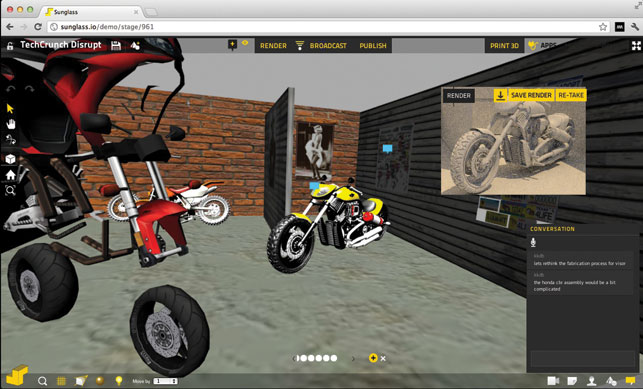The collaboration theme has been a big push for software developers over the past five years. It’s just not good enough to shove a file in an email anymore, there has to be a better way of doing this distribution thing.

Sunglass allows direct integration with SolidWorks, SketchUp and Rhino
So far we have had battles of View and Mark-up applications, then 3D formats (PDF, 3DXML, JT etc.) and now the growth of the cloud, or ‘collaboration portals’, which have been as complicated as a document management system or simple as Dropbox.
New start–up, the oddly named ‘Sunglass.io’, founded in May 2011, has recently launched a new take on sharing 3D designs via the cloud. The company makes a bold claim that it will “revolutionise the $10 billion CAD industry” with its product and has been generating a fair amount of noise on the tech talk circuit showing its product while it has been in development.
At the moment Sunglass isn’t a ‘proper’ CAD system as such but a way to convert 3D CAD designs into B–REP models (surfaces defined by boundary representation) and then holding them in an online webGL–based environment for sharing. In time, tools and applications will become available to enable a wide range of ‘things’ which can be done to and with models. In its current guise it is focussing on the sharing aspect.
The company was founded by two Massachusetts Institute of Technology (MIT) graduates – Nitin Rao and CEO Kaustuv DeBiswas. The pair set up a research project called dplay, that developed a real-time collaborative design environment from which Sunglass appears to have grown. Rao says he has been driven by the cost of existing design software and how it’s too expensive for emerging countries.
There’s also an issue where people can’t be part of the design conversation as they don’t have the right tools so they can’t express themselves.
In recent tech conferences, the company has shown some of the Sunglass technology, which offered analysis-ready models, combined with the massive parallel processing capabilities of the cloud. In one significant demonstration, it showed how a bike was designed in collaboration with teams in India performing multiple, simultaneous tasks on the model.
However, editing and geometry creation capabilities are currently in beta, so were not pushed in our interview with Rao and DeBiswas.
Being cloud–based you can plug a Sunglass embed code into any web page, which allows others to manipulate your designs without Adobe Flash (Sunglass is powered by WebGL and HTML5). Enabling geographically displaced teams to work on the same model at the same time has long been the holy grail for many CAD firms but none have really hit the spot, although ImpactXoft and subsequently Dassault Systèmes is giving this a lot of development effort.
There is a question still as to how natural and beneficial it is to have many hands hacking at a 3D model simultaneously, as opposed to working individual parts of an assembly. Perhaps one reason why is that it has yet to get fully deployed anywhere.
Attilio Rimoldi, the founder of ImpactXoft developed, with Toyota Caelum, demonstrated simultaneous modelling on the same 3D CAD geometry. This was in back in 1999, so was well ahead of the curve and later licensed technology to Dassault Systèmes and Autodesk. [Editor’s note – it seems we were misinformed and Attilio Rimoldi is alive and well and still developing great CAD software in Italy]
Getting data in
Sunglass works with files from SolidWorks, SketchUp and Rhino, where it’s simple drag and drop to upload CAD designs to Sunglass’ online viewer and editor. Sunglass also lets you grab and save models to the cloud storage services of DropBox and Box. The company has also developed its own tool for cloud-based streaming that can render 3D objects in 20 to 45 seconds.
API
The company’s newly released API (Application Programming Interface) is enabling integrations and functional enhancements.
They are also searching for developers to build on top of their cloud platform and will include an App store for third party tools. Sunglass can be expanded as the need arises as opposed to buying an expensive suite.
When asked who these developers could be, Rao said that they “probably wouldn’t be traditional CAD developers to start with” and wouldn’t divulge any company names.
In fact, the main user of the API seems to currently be Sunglass itself. Rao said they aim to make Sunglass more fully-featured over the next few months and are working on a way to enable phone calls within its cloud platform using Twilio, which would make it easier for users to collaborate.
He also indicated that they are working on streaming and version control, features that would make collaborating on 3D projects easier.
Conclusion
It’s hard to make a long term judgement on Sunglass.io. Like SpaceClaim, a company comes into the CAD market, says it’s not in competition, provides useful functionality but all the time the development strategy looks to be to develop a CAD system which will threaten the existing players at some point, perhaps.
This will probably win them few friends and they may find it hard to find developers who will create tools for a product that has few customers. It’s the old chicken and egg issue. Rao and DeBiswas went out of their way to say that they were not in competition but all the marketing and future capability neuters that claim.
The idea of cloud collaboration is not new, but perhaps the approach and dedication to its creation will mean that Sunglass will find a place in the market.
If the product is competitively priced and offers many benefits, the company could find its home, as well as drive innovation within the other traditional CAD players. At worst, it will prove popular with the SketchUp base and operate in the freeware market.
However, my gut reaction is that Sunglass is a technology in search of a problem. Both DeBiswas and Rao admitted that they needed to offer an initial service which solved pain points while they developed the rest of the application and courted plug-in developers.
With such a wide range of target markets (MCAD, AEC and the vast SketchUp masses), something will probably stick.
There is nothing wrong with rethinking the way things currently work to make use of new technologies, the tough part will be providing the depth of functionality that is already provided in traditional CAD systems, which has been developed over decades.
www.sunglass.io

A 3D design platform that adds direct integration with major desktop software tools
Default








